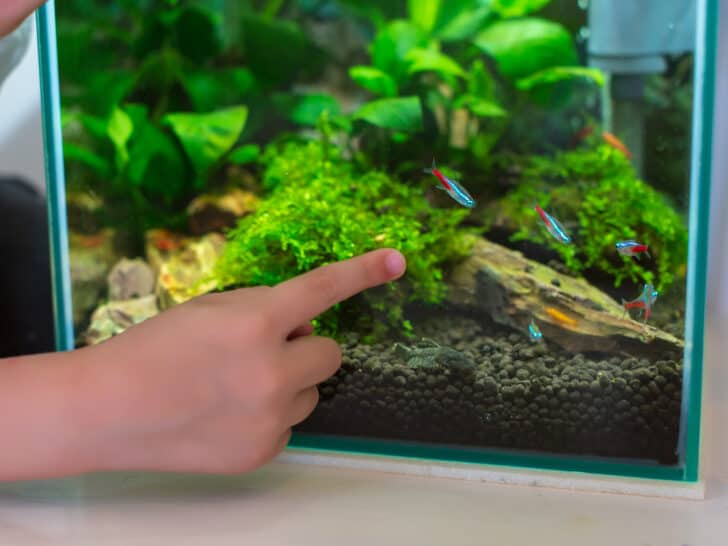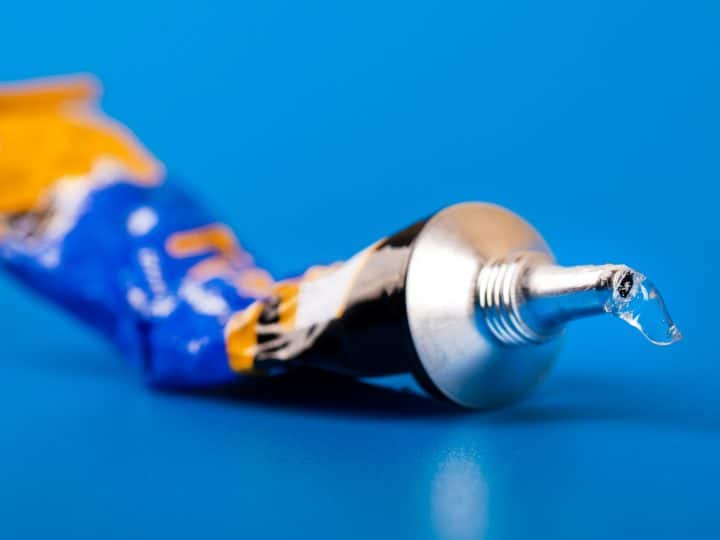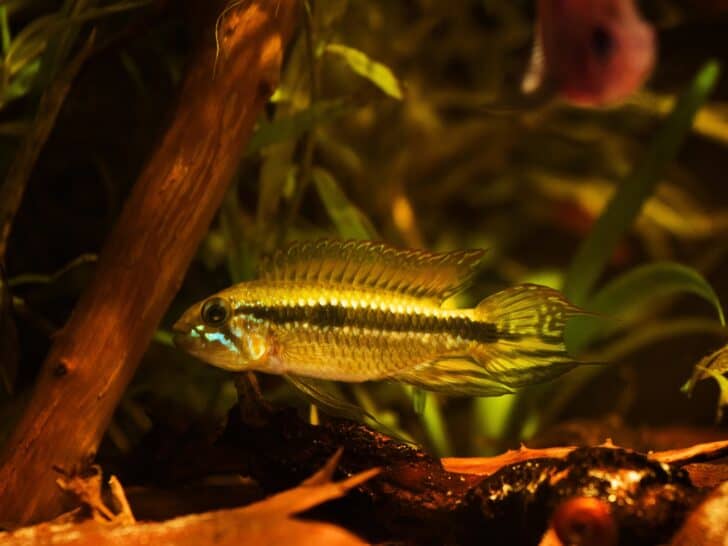To make a moss wall in your aquarium, first choose the right kind of moss then decontaminate it. You’ll then have to anchor it to a piece of driftwood, a rock, or mesh, place it inside of the aquarium, provide it with nutrients, and then let it grow. It will also require constant maintenance.
How to Make an Aquarium Moss Wall: Step-by-Step
Now that you know what exactly an aquarium moss wall is, let me take you on a step-by-step tutorial on exactly how to make one.
1. Choose Your Moss
The first step here is to choose the right kind of moss for your aquarium. If you want to go with something super easy, Java moss is probably the best one of all. It’s extremely resilient, it doesn’t require anything special to grow, and it’s easy to attach to a variety of surfaces.
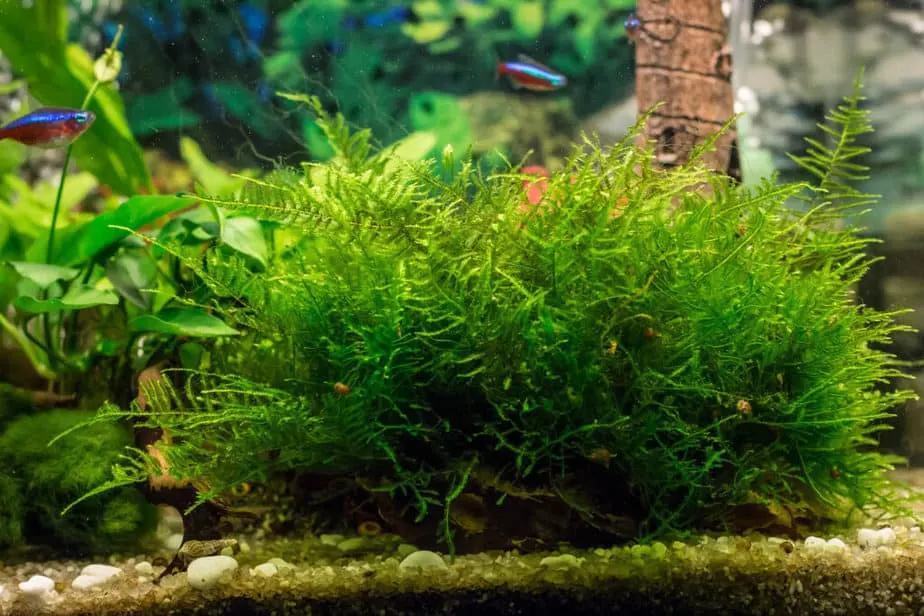
If you aren’t a fan of the appearance of Java moss, and you’d like something with longer branches and broader leaves, willow moss is another good option to consider. This is also a good option because it doesn’t require much light or nutrition, and easily attaches to rocks and driftwood.
Another one of my personal favorites is weeping moss, which is very slow growing, dense, and overhanging. It requires a bit of effort to maintain, but it’s an ideal option for vertical applications. Yet another good option is flame moss, which looks very cool because it tends to grow straight upwards, and almost looks like a green flames.
If you like the look of Christmas trees, Christmas moss is a good option to consider. As the name implies, it resembles a Christmas tree, and one of its most common applications is to create moss walls in planted aquariums. In fact, in terms of the ease of making a moss wall, this is one of my primary recommendations.
It doesn’t end there, because there are still plenty of other types of moss that you can use here. These include, but are not limited to, many Taiwan moss, Peacock moss, Taiwan moss, Cameron moss, star moss, and more. I recommend doing some research into the specific type of moss you want, as this is quite likely the most important step of all.
2. Decontaminate the Moss
Before you start doing anything with the moss, you want to decontaminate it. You don’t want unwanted hitchhikers getting into your tank via the new moss you just bought.
Therefore, create a diluted bleach solution of 19 parts water and 1 part bleach. Soak the moss in this diluted bleach mixture for up to 5 minutes, but no longer.
You can then take the moss out and thoroughly rinse it under cool water. Make sure to rinse it extremely thoroughly, because you don’t want to introduce bleach into your tank. Your moss should now be decontaminated and ready to be pushed in a tank.
3. Purchase Anchors of Choice
Here is where things get interesting because now you need to start thinking about how you are actually going to build that moss wall, and whether you want it to be vertical or horizontal.
If you want a vertical moss wall, you’ll need anchors that you can either tie to the side of your aquarium or lean against the glass.
Using thin and flat rocks, pieces of driftwood that you can place beside each other, or even some kind of mesh or netting that you can tie to your aquarium wall is ideal.
Although driftwood looks nice, I personally recommend using some kind of mesh or grid, as this will allow the moss to spread across the entirety of the wall. There are even special aquarium moss wall kits you can purchase that come with the mesh grids included!
4. Securely Attach the Moss to the Anchors
Once you have your anchors, you can then use some basic fishing line to gently but securely tie your moss of choice to the anchors.
Getting this right might take a bit of trial and error, and exactly how you do it depends on the type of moss and anchors you have, so this is something you’ll have to kind of figure out for yourself.
5. Place the Anchored Moss in the Aquarium
Once you have the moss tied to your anchors, it’s time to insert it into the aquarium. Once again, exactly how you place this into the aquarium, where you place it, and how you choose to secure the moss and the anchors is up to you.
This will all depend on the size of the aquarium, the positioning of your moss wall, and the type of moss and anchors you are using.
For instance, if you are trying to make a vertical moss wall using driftwood as an anchor, I recommend tying at least three or four bunches of moss to individual anchors, and then placing those driftwood anchors vertically against your aquarium wall with regular spacing in between. Eventually, that moss will spread.
6. Provide Your Moss with Some Fertilizer
If you think that your aquarium does not have enough nutrients to allow the moss to grow fast and strong, providing it with some liquid fertilizer is something to consider.
Many types of aquarium plants also do really well with additional carbon dioxide injection. Also, make sure that the moss gets plenty of natural light, because plants like moss require photosynthesis in order to grow.
7. Maintain the Ever-Growing Moss Wall
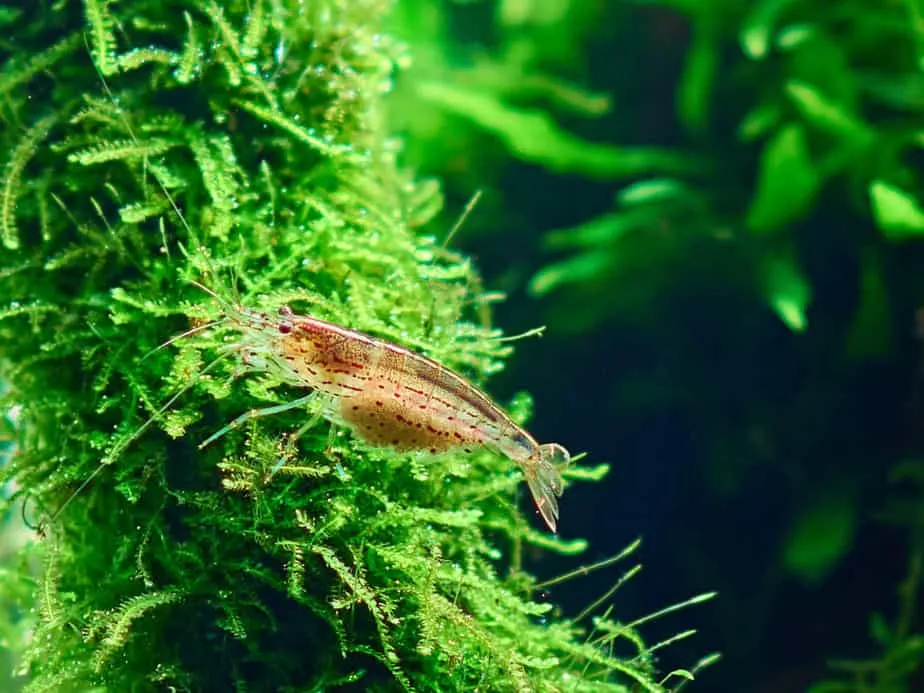
Growing a moss wall in an aquarium is no exact science. You might have to move things around every now and again to create solid coverage, you might need to do some fertilizing, some trimming and pruning, and so on and so forth.
Why Create a Moss Wall in Your Aquarium?
Before I wrap things up for today, I quickly want to touch on the main reasons why I think moss walls are good ideas to put in aquariums.
- First and foremost, moss walls look very nice. I’ve never had a freshwater aquarium that looked better than the one where I grew a massive moss wall.
- Moss walls also provide beneficial bacteria with a great breeding ground, therefore providing your aquarium with increased biological filtration capabilities.
- Moss walls also provide smaller fish with both hiding spots and foraging grounds for food.
- Many types of aquarium moss also act as fantastic water filtration units in themselves, therefore helping to keep your tank just that much cleaner alongside your filtration unit.
What Is an Aquarium Moss Wall?
As the name implies, here I am talking about a submerged mass of moss inside of your planted tank.
There are many different kinds of aquarium moss that you can use for this purpose, and I personally like Java moss, although there are many to choose from.
The point here is to create a solid and flat wall of moss that either sits against your aquarium wall or blankets the bottom of the aquarium like a beautiful green carpet.
Conclusion
When all that has been said and done, growing a moss wall in an aquarium has been perhaps one of my favorite projects of all. Moss walls make for fantastic additions to planted aquariums for a variety of reasons, and it’s something I recommend trying.

